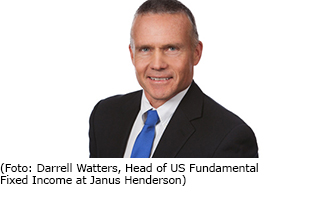
Janus Henderson: US debt - upping the ante on growth
In this article, Darrell Watters, Head of North America Fixed Income at Janus Henderson Investors, provides his views on the impact of the additional US government spending that is as a result of the recently approved budget deal by the US Congress.
13.03.2018 | 13:08 Uhr
 The United States Congress recently approved a two-year budget deal that allows for roughly $400bn in additional US government spending. This comes on the heels of the US tax code overhaul, which is expected to drastically reduce federal revenue in the coming decade. Ideally, these fiscal initiatives will spur capital investment from corporations and encourage consumer spending. Such an environment could allow US gross domestic product (GDP) to grow at a rate above 3%, propelling the economy to escape velocity and holding the deficit at a manageable level. Keeping the train on the tracks, however, is not without challenges.
The United States Congress recently approved a two-year budget deal that allows for roughly $400bn in additional US government spending. This comes on the heels of the US tax code overhaul, which is expected to drastically reduce federal revenue in the coming decade. Ideally, these fiscal initiatives will spur capital investment from corporations and encourage consumer spending. Such an environment could allow US gross domestic product (GDP) to grow at a rate above 3%, propelling the economy to escape velocity and holding the deficit at a manageable level. Keeping the train on the tracks, however, is not without challenges.
An off-track economy
The US is already off-track from a traditional economic standpoint. Typically, at this expansionary stage in the economic cycle, the country should be operating with a budget surplus in the 3-5% range. That surplus should be used to pay down debt.
Instead, the US closed the 2017 fiscal year with a budget deficit of $666bn. Thanks to lower tax revenues and increased government spending, that figure could climb to over $1trn in coming years. This dramatically raises the stakes on US economic growth: in order to meet the cost of its debt and keep the deficit in check, the country needs strong and sustainable growth.
Is stronger growth possible?
After the 2008 financial crisis, the US Federal Reserve (Fed) reduced interest rates to record lows and injected massive amounts of stimulus into the economy, expanding the country’s balance sheet to $4.5trn through quantitative easing measures. While we have witnessed a recovery stemming from monetary policy alone, it has been one of low velocity and tepid growth.
Now we face a pullback in monetary stimulus, and fiscal stimulus is filling the void. If the latter fails to generate notably higher growth, and instead simply generates a materially wider deficit, it will weigh on the value of the US dollar, fuelling inflationary pricing pressures.
Uncertainty in a consumer-led economy
The challenge for the US is that consumer spending drives approximately 70% of the economy, and consumer habits are unpredictable. In 2017, growth in consumer spending outpaced that of personal income, and the personal savings rate hit a 12-year low. If consumers become concerned over savings erosion, they may begin to pare back purchases, perhaps even in the first half of this year. Additionally, if fiscal stimulus spurs productivity-enhancing capital investment at the expense of employee headcount, the prospect of consumer-driven growth becomes questionable and for some consumers, inflationary pressures alone could be sufficient to rein in their spending. These scenarios would compromise the growth expectations already embedded in 2018 forecasts. In the event the growth rate starts moving in the wrong direction, the deficit would balloon even further.
However, there could still be a surprise to the upside. If Congress can push through spending constraints and pull the deficit back to a healthier level, the economy could really take off. This feat would be well received by investors and likely result in higher stock prices, flat to modestly tighter credit spreads and a stronger dollar.
Impact on Treasury supply
Without some form of spending constraints from Congress, the budget increase will add supply to the US Treasury market as the Fed scales back purchases and many large foreign buyers look to curb their Treasury allocations. Uncertainty around how the increase of supply in the belly of the yield curve will be absorbed, coupled with concerns that the Fed could derail economic growth in its attempts to normalise interest rates, could continue to push front-end Treasury yields higher.
The long end of the curve, however, should exhibit more stability, supported by scepticism over US economic growth and investors seeking safety in the event of Fed policy error. Therefore, a flatter yield curve and range-bound rates remain likely.



Diesen Beitrag teilen: